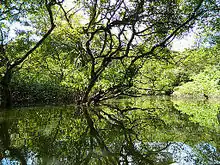Rainwater harvesting
Rainwater harvesting (RWH) is the collection and storage of rain, rather than allowing it to run off. Rainwater is collected from a roof-like surface and redirected to a tank, cistern, deep pit (well, shaft, or borehole), aquifer, or a reservoir with percolation. Dew and fog can also be collected with nets or other tools. Rainwater harvesting differs from stormwater harvesting as the runoff is collected from roofs, rather than creeks, drains, roads, or any other land surfaces.[1][2] Its uses include watering gardens, livestock,[3] irrigation, domestic use with proper treatment, and domestic heating. The harvested water can also be committed to longer-term storage or groundwater recharge.[4]
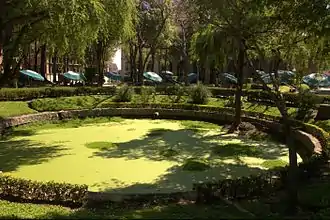
Rainwater harvesting is one of the simplest and oldest methods of self-supply of water for households, and residential and household-scale projects, usually financed by the user.[5] However, larger systems for schools, hospitals, and other facilities can run up costs only able to be financed by owners, organizations, and governmental units.
History of rainwater harvesting
The construction and use of cisterns to store rainwater can be traced back to the Neolithic Age, when waterproof lime plaster cisterns were built in the floors of houses in village locations of the Levant, a large area in Southwest Asia, south of the Taurus Mountains, bound by the Mediterranean Sea in the west, the Arabian Desert in the south, and Mesopotamia in the east. By the late 4000 BC, cisterns were essential elements of emerging water management techniques used in dry-land farming.[6]
Many ancient cisterns have been discovered in some parts of Jerusalem and the entire Land of Israel. At the site believed by some to be that of the biblical city of Ai (Khirbet et-Tell), a large cistern dating back to around 2500 BC was discovered that had a capacity of nearly 1,700 m3 (60,000 cu ft). It was carved out of a solid rock, lined with large stones, and sealed with clay to keep from leaking.[6]

The Greek island of Crete is also known for its use of large cisterns for rainwater collection and storage during the Minoan period from 2,600 BC–1,100 BC. Four large cisterns have been discovered at Myrtos–Pyrgos, Archanes, and Zakroeach. The cistern found at Myrtos-Pyrgos was found to have a capacity of more than 80 m3 (2,800 cu ft) and date back to 1700 BC.[6]
Around 300 BC, farming communities in Balochistan (now located in Pakistan, Afghanistan, and Iran), and Kutch, India, used rainwater harvesting for agriculture and many other uses.[7] Rainwater harvesting was done by Chola kings as well.[8] Rainwater from the Brihadeeswarar temple (located in Balaganpathy Nagar, Thanjavur, India) was collected in Shivaganga tank.[9] During the later Chola period, the Vīrānam tank was built (1011 to 1037 AD) in the Cuddalore district of Tamil Nadu to store water for drinking and irrigation purposes. Vīrānam is a 16-km-long tank with a storage capacity of 1,465,000,000 cu ft (41,500,000 m3).
Rainwater harvesting was also common in the Roman Empire.[10] While Roman aqueducts are well-known, Roman cisterns were also commonly used and their construction expanded with the Empire.[6] For example, in Pompeii, rooftop water storage was common before the construction of the aqueduct in the 1st century BC.[11] This history continued with the Byzantine Empire; for example, the Basilica Cistern in Istanbul.
Though little-known, for centuries the town of Venice depended on rainwater harvesting. The lagoon which surrounds Venice is brackish water, which is not suitable for drinking. The ancient inhabitants of Venice established a system of rainwater collection which was based on man-made insulated collection wells.[12] Water percolated down the specially designed stone flooring, and was filtered by a layer of sand, then collected at the bottom of the well. Later, as Venice acquired territories on the mainland, it started to import water by boat from local rivers, but the wells remained in use and were especially important in the time of war when access to the mainland water could be blocked by an enemy.
Canada
Several Canadians have started implementing rainwater harvesting systems for use in stormwater reduction, irrigation, laundry, and lavatory plumbing. Substantial reform to Canadian law since the mid-2000s has increased the use of this technology in agricultural, industrial, and residential use, but ambiguity remains amongst legislation in many provinces. Bylaws and local municipal codes often regulate rainwater harvesting.
India
- Tamil Nadu was the first state to make rainwater harvesting compulsory for every building to avoid groundwater depletion. The project was launched in 2001 and has been implemented in all rural areas of Tamil Nadu. Posters all over Tamil Nadu including rural areas create awareness about harvesting rainwater. TN Govt site. It gave excellent results within five years, and slowly every state took it as a role model. Since its implementation, Chennai had a 50% rise in water level in five years and the water quality significantly improved.[13]
- Karnataka: In Bangalore, adoption of rainwater harvesting is mandatory for every owner or the occupier of a building having the site area measuring 60 ft (18.3 m) × 40 ft (12.2 m) and above and for a newly constructed building measuring 30 ft (9.1 m) × 40 ft (12.2 m) and above dimensions. In this regard, Bangalore Water Supply and Sewerage Board has initiated and constructed “Rain Water Harvesting Theme Park” in the name of Sir M. Visvesvaraya in 1.2 acres (4,900 m2) of land situated at Jayanagar, Bangalore. In this park, 26 different types of rainwater harvesting models are demonstrated along with the water conservation tips. The auditorium on the first floor is set up with a "green" air conditioning system and will be used to arrange the meeting and showing of a video clip about the rainwater harvesting to students and the general public.[14] An attempt has been made at the Department of Chemical Engineering, IISc, Bangalore to harvest rainwater using the upper surface of a solar still, which was used for water distillation[15]
- In Rajasthan, rainwater harvesting has traditionally been practiced by the people of the Thar Desert. Many ancient water harvesting systems in Rajasthan have now been revived.[16] Water harvesting systems are widely used in other areas of Rajasthan, as well, for example, the chauka system from the Jaipur district.[17]
- Maharashtra: At present, in Pune, rainwater harvesting is compulsory for any new housing society to be registered.
- In Mumbai, Maharashtra, rainwater harvesting is not mandatory. The Municipal Corporation of Greater Mumbai is planning to make rainwater harvesting mandatory for large societies.[18]
Israel
The Southwest Center for the Study of Hospital and Healthcare Systems in cooperation with Rotary International is sponsoring a rainwater harvesting model program across the country. The first rainwater catchment system was installed at an elementary school in Lod, Israel. The project is looking to expand to Haifa in its third phase. The Southwest Center has also partnered with the Water Resources Action Project of Washington, DC, which currently has rainwater harvesting projects in the West Bank. Rainwater harvesting systems are being installed in local schools to educate schoolchildren about water conservation principles and bridge divides between people of different religious and ethnic backgrounds, all while addressing the water scarcity issue that the Middle East faces.[19] [20]
New Zealand
Although New Zealand has plentiful rainfall in the West and South, for much of the country, rainwater harvesting is the normal practice for most rural housing and is encouraged by most councils.[21]
Sri Lanka
Rainwater harvesting has been a popular method of obtaining water for agriculture and for drinking purposes in rural homes. The legislation to promote rainwater harvesting was enacted through the Urban Development Authority (Amendment) Act, No. 36 of 2007.[22] Lanka rainwater harvesting forum[23] is leading Sri Lanka's initiative.
South Africa
The South African Water Research Commission has supported research into rainwater harvesting. Reports on this research are available on their "Knowledge Hub".[24] Studies in arid, semiarid, and humid regions have confirmed that techniques such as mulching, pitting, ridging, and modified run-on plots are effective for small-scale crop production.[25] hydrofracturing has regularly been used to improve the performance of water boreholes. From 1990 to 1992, 170 boreholes had been hydrofractured.[26]
United Kingdom
In the United Kingdom, water butts are often found in domestic gardens and on allotments to collect rainwater, which is then used to water the garden. However, the British government's Code for Sustainable Homes encouraged fitting large underground tanks to newly built homes to collect rainwater for flushing toilets, watering, and washing. Ideal designs had the potential to reduce demand on mains water supply by half. The code was revoked in 2015.
Other countries
- In China, Argentina, and Brazil, rooftop rainwater harvesting is being done for livestock, water for small irrigation, and a way to replenish groundwater levels. Gansu province in China and semiarid northeast Brazil have the largest rooftop rainwater harvesting projects going on.
- Thailand has the largest fraction of the population in the rural area relying on rainwater harvesting (currently around 40%).[27] Rainwater harvesting was promoted heavily by the government in the 1980s. In the 1990s, after government funding for the collection tanks ran out, the private sector stepped in and provided several million tanks to private households, many of which continue to be used.[28] This is one of the largest examples of self-supply of water worldwide.
.jpg.webp)
- In Bermuda, the law requires all new construction to include rainwater harvesting adequate for the residents.[29]
- The U.S. Virgin Islands has a similar law.
- In Senegal and Guinea-Bissau, the houses of the Diola-people are frequently equipped with homebrew rainwater harvesters made from local, organic materials.
- In the Irrawaddy Delta of Myanmar, the groundwater is saline, and communities rely on mud-lined rainwater ponds to meet their drinking water needs throughout the dry season. Some of these ponds are centuries old and are treated with great reverence and respect.
- In the United States, until 2009 in Colorado, water rights laws almost completely restricted rainwater harvesting; a property owner who captured rainwater was deemed to be stealing it from those who have the rights to take water from the watershed. Now, residential good owners who meet certain criteria may obtain a permit to install a rooftop precipitation collection system (SB 09-080).[30] Up to 10 large scale pilot studies may also be permitted (HB 09-1129).[31] The main factor in persuading the Colorado Legislature to change the law was a 2007 study that found that in an average year, 97% of the precipitation that fell in Douglas County, in the southern suburbs of Denver, never reached a stream—it was used by plants or evaporated on the ground. Rainwater catchment is mandatory for new dwellings in Santa Fe, New Mexico.[32] Texas offers a sales tax exemption on the purchase of rainwater harvesting equipment. Both Texas[33] and Ohio allow the practice even for potable purposes. Oklahoma passed the Water for 2060 Act in 2012, to promote pilot projects for rainwater and graywater use among other water-saving techniques.[34]
- In Beijing, some housing societies are now adding rainwater in their main water sources after proper treatment.
- In Ireland, Professor Micheal Mcginley established a project to design a rainwater harvesting prototype in the biosystems design challenge module at University College Dublin.
New approaches
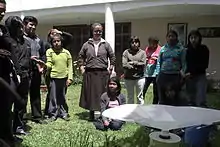
Instead of using the roof for catchment, the RainSaucer, which looks like an upside-down umbrella, collects rain straight from the sky. This decreases the potential for contamination and makes RainSaucer a potential application for potable water in developing countries.[35] Other applications of this free-standing rainwater collection approach are sustainable gardening and small-plot farming.[36]
A Dutch invention called the Groasis Waterboxx is also useful for growing trees with harvested and stored dew and rainwater.
Traditionally, stormwater management using detention basins served a single purpose. However, optimized real-time control lets this infrastructure double as a source of rainwater harvesting without compromising the existing detention capacity.[37] This has been used in the EPA headquarters to evacuate stored water prior to storm events, thus reducing wet weather flow while ensuring water availability for later reuse. This has the benefit of increasing water quality released and decreasing the volume of water released during combined sewer overflow events.[38][39]
Generally, check dams are constructed across the streams to enhance the percolation of surface water into the subsoil strata. The water percolation in the water-impounded area of the check dams can be enhanced artificially manyfold by loosening the subsoil strata and overburden using ANFO explosives as used in open cast mining. Thus, local aquifers can be recharged quickly using the available surface water fully for use in the dry season.
Nontraditional
In 1992, American artist Michael Jones McKean created artwork in Omaha, Nebraska, at the Bemis Center for Contemporary Art that created a fully sustainable rainbow in the Omaha skyline. The project collected thousands of gallons of rainwater, storing the water in six daisy-chained 12,000 gallons tanks.[40] The massive logistical undertaking, during its five-month span, was one of the largest urban rainwater harvesting sites in the American Midwest.
Rainwater harvesting by freshwater-flooded forests
Rainwater harvesting is possible by growing freshwater-flooded forests without losing the income from the used, submerged land.[41] The main purpose of the rainwater harvesting is to use the locally available rainwater to meet water requirements throughout the year without the need of huge capital expenditure. This would facilitate the availability of uncontaminated water for domestic, industrial, and irrigation needs.
Rainwater harvesting by solar power panels
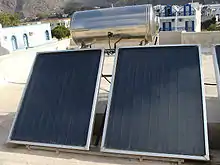
Good quality water resource, closer to populated areas, is becoming scarce and costly for the consumers. In addition to solar and wind energy, rainwater is major renewable resource of any land. The vast area is being covered by solar PV panels every year in all parts of the world. Solar panels can also be used for harvesting most of the rainwater falling on them and drinking quality water, free from bacteria and suspended matter, can be generated by simple filtration and disinfection processes as rainwater is very low in salinity.[42][43][44] Exploitation of rainwater for value-added products like bottled drinking water, makes solar PV power plants profitable even in high rainfall/ cloudy areas by the augmented income from value-added drinking water generation. Recently cost-effective Rainwater collection in the already dug wells found to be highly effective in bringing groundwater level up in India.
Advantages
Rainwater harvesting provides the independent water supply during regional water restrictions, and in developed countries, it is often used to supplement the main supply. It provides water when a drought occurs, can help mitigate flooding of low-lying areas, and reduces demand on wells which may enable groundwater levels to be sustained. It also helps in the availability of potable water, as rainwater is substantially free of salinity and other salts. Applications of rainwater harvesting in urban water system provides a substantial benefit for both water supply and wastewater subsystems by reducing the need for clean water in water distribution systems, less generated stormwater in sewer systems,[45] and a reduction in stormwater runoff polluting freshwater bodies.
.jpg.webp)
A large body of work has focused on the development of life cycle assessment and its costing methodologies to assess the level of environmental impacts and money that can be saved by implementing rainwater harvesting systems.[44]
Independent water supply
Rainwater harvesting provides an independent water supply during water restrictions. In areas where clean water is costly, or difficult to come by, rainwater harvesting is a critical source of clean water. In developed countries, rainwater is often harvested to be used as a supplemental source of water rather than the main source, but the harvesting of rainwater can also decrease a household's water costs or overall usage levels. Rainwater is safe to drink if the consumers do additional treatments before drinking. Boiling water helps to kill germs. Adding another supplement to the system such as a first flush diverter is also a common procedure to avoid contaminants of the water.[46]
Supplemental in drought
When drought occurs, rainwater harvested in past months can be used. If rain is scarce but also unpredictable, the use of a rainwater harvesting system can be critical to capturing the rain when it does fall. Many countries with arid environments, use rainwater harvesting as a cheap and reliable source of clean water. To enhance irrigation in arid environments, ridges of soil are constructed to trap and prevent rainwater from running downhills. Even in periods of low rainfall, enough water is collected for crops to grow. Water can be collected from roofs and tanks can be constructed to hold large quantities of rainwater.
In addition, rainwater harvesting decreases the demand for water from wells, enabling groundwater levels to be further sustained rather than depleted.
Life-cycle assessment
Life-cycle assessment is a methodology used to evaluate the environmental impacts of a system from cradle-to-grave of its lifetime. Devkota et al,[47][48] developed such a methodology for rainwater harvesting, and found that the building design (e.g., dimensions) and function (e.g., educational, residential, etc.) play critical roles in the environmental performance of the system. The Economic and Environmental Analysis of Sanitations Technologies, EEAST model evaluates the greenhouse gas emissions and cost of such systems over the lifetime of a variety of building types.
To address the functional parameters of rainwater harvesting systems, a new metric was developed - the demand to supply ratio (D/S) - identifying the ideal building design (supply) and function (demand) in regard to the environmental performance of rainwater harvesting for toilet flushing. With the idea that supply of rainwater not only saves the potable water but also saves the stormwater entering the combined sewer network (thereby requiring treatment), the savings in environmental emissions were higher if the buildings are connected to a combined sewer network compared to separate one.[48]
Cost-effectiveness
Although standard RWH systems can provide a water source to developing regions facing poverty, the average cost for an RWH setup can be costly depending on the type of technology used. Governmental aid and NGOs can assist communities facing poverty by providing the materials and education necessary to develop and maintain RWH setups.[49]
Some studies show that rainwater harvesting is a widely applicable solution for water scarcity and other multiple usages, owing to its cost-effectiveness and eco-friendliness.[50][49] Constructing new substantial, centralized water supply systems, such as dams, is prone to damage local ecosystems, generates external social costs, and has limited usages, especially in developing countries or impoverished communities. On the other hand, installing rainwater harvesting systems is verified by a number of studies to provide local communities a sustainable water source, accompanied by other various benefits, including protection from flood and control of water runoff, even in poor regions.[49][51] Rainwater harvesting systems that do not require major construction or periodic maintenance by a professional from outside the community are more friendly to the environment and more likely to benefit the local people for a longer period of time.[49] Thus, rainwater harvesting systems that could be installed and maintained by local people have bigger chances to be accepted and used by more people.
The usage of in-situ technologies can reduce investment costs in rainwater harvesting. In-situ technologies for rainwater harvesting could be a feasible option for rural areas since less material is required to construct them. They can provide a reliable water source that can be utilized to expand agricultural outputs. Above-ground tanks can collect water for domestic use; however, such units can be unaffordable to people in poverty.[52]
Limitations
Select suitable sites for harvesting rainwater
Rainwater harvesting is a widely used method of storing rainwater in the countries presenting with drought characteristics. Several pieces of research have derived and developed different criteria and techniques to select suitable sites for harvesting rainwater. Some research was identified and selected suitable sites for the potential erection of dams, as well as derived a model builder in ArcMap 10.4.1. The model combined several parameters, such as slope, runoff potential, land cover/use, stream order, soil quality, and hydrology to determine the suitability of the site for harvesting rainwater.[53]
Harvested water from RWH systems can be minimal during below-average precipitation in arid urban regions such as the Mideast. RWH is useful for developing areas as it collects water for irrigation and domestic purposes. However, the gathered water should be adequately filtered to ensure safe drinking.[54]
Quality of water harvesting
Rainwater may need to be analyzed properly, and used in a way appropriate to its safety. In the Gansu province, for example, solar water disinfection is used by boiling harvested rainwater in parabolic solar cookers before being used for drinking.[55] These so-called "appropriate technology" methods provide low-cost disinfection options for treatment of stored rainwater for drinking.
While rainwater itself is a clean source of water, often better than groundwater or water from rivers or lakes,[56] the process of collection and storage often leaves the water polluted and non-potable. Rainwater harvested from roofs can contain human, animal and bird feces, mosses and lichens, windblown dust, particulates from urban pollution, pesticides, and inorganic ions from the sea (Ca, Mg, Na, K, Cl, SO4), and dissolved gases (CO2, NOx, SOx). High levels of pesticide have been found in rainwater in Europe with the highest concentrations occurring in the first rain immediately after a dry spell;[57] the concentration of these and other contaminants are reduced significantly by diverting the initial flow of run-off water to waste. Improved water quality can also be obtained by using a floating draw-off mechanism (rather than from the base of the tank) and by using a series of tanks, withdraw from the last in series. Prefiltration is a common practice used in the industry to keep the system healthy and ensure that the water entering the tank is free of large sediments.
A very interesting concept of rainwater harvesting and cleaning it with solar energy for rural household drinking purposes has been developed by Nimbkar Agricultural Research Institute.[58]
Conceptually, a water supply system should match the quality of water with the end-user. However, in most of the developed world, high-quality potable water is used for all end uses. This approach wastes money and energy and imposes unnecessary impacts on the environment. Supplying rainwater that has gone through preliminary filtration measures for non-potable water uses, such as toilet flushing, irrigation, and laundry, maybe a significant part of a sustainable water management strategy.
System setup
Rainwater harvesting systems can range in complexity, from systems that can be installed with minimal skills, to automated systems that require advanced setup and installation. The basic rainwater harvesting system is more of a plumbing job than a technical job, as all the outlets from the building's terrace are connected through a pipe to an underground tank that stores water. There are common components that are installed in such systems, such as pre-filters (see e.g. vortex filter), drains/gutters, storage containers, and depending on whether the system is pressurized, also pumps, and treatment devices such as UV lights, chlorination devices and post-filtration equipment.
Systems are ideally sized to meet the water demand throughout the dry season since it must be big enough to support daily water consumption. Specifically, the rainfall capturing area such as a building roof must be large enough to maintain an adequate flow of water. The water storage tank size should be large enough to contain the captured water. For low-tech systems, many low-tech methods are used to capture rainwater: rooftop systems, surface water capture, and pumping the rainwater that has already soaked into the ground or captured in reservoirs and storing it in tanks (cisterns).
Applications of rainwater harvesting
Agriculture
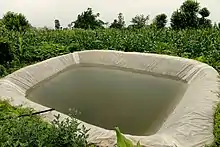
In regards to Urban agriculture, rainwater harvesting in urban areas reduces the impact of runoff and flooding. The combination of urban ‘green’ rooftops with rainwater catchments have been found to reduce building temperatures by more than 1.3 degrees Celsius.[59] Rainwater harvesting in conjunction with urban agriculture would be a viable way to help meet the United Nations Sustainable Development Goals for cleaner and sustainable cities, health and wellbeing, and food and water security. The technology is available, however, it needs to be remodeled in order to use water more efficiently, especially in an urban setting.
Kenya has already been successfully harvesting rainwater for toilets, laundry, and irrigation and areas in Australia use harvested rainwater for cooking and drinking.[59] Studies done by Stout et al researching the feasibility in India found RWH was most beneficial used for small-scale irrigation, which provides income with the sales of produce, and overflow used for groundwater recharge.[59]
Missions to five Caribbean countries have shown that the capture and storage of rainwater runoff for later use is able to significantly reduce the risk of losing some or all of the year's harvest because of soil or water scarcity. In addition, the risks associated with flooding and soil erosion during high rainfall seasons would decrease. Small farmers, especially those farming on hillsides, could benefit the most from rainwater harvesting because they are able to capture runoff and decrease the effects of soil erosion.[60]
Many countries, especially those with arid environments, use rainwater harvesting as a cheap and reliable source of clean water.[61] To enhance irrigation in arid environments, ridges of soil are constructed to trap and prevent rainwater from running down hills and slopes. Even in periods of low rainfall, enough water is collected for crops to grow.[62] Water can be collected from roofs, dams and ponds can be constructed to hold large quantities of rainwater so that even on days when little to no rainfall occurs, enough is available to irrigate crops.
Domestic use
.jpg.webp)
- In China, Argentina, and Brazil, rooftop rainwater harvesting is used to provide drinking water, domestic water, water for livestock, water for small irrigation, and a way to replenish groundwater levels. Gansu province in China and semiarid northeast Brazil have the largest rooftop rainwater harvesting projects going on.
- About 40% of Thailand's rural population utilizes rainwater harvesting.[27] Rainwater harvesting was promoted heavily by the government in the 1950s. In the 1990s, after government funding for the collection tanks ran out, the private sector stepped in and provided several million tanks to private households, many of which continue to be used today.[28] This is one of the largest examples of self-supply of water worldwide.
- Rainwater harvesting is mandatory for new homes built in Santa Fe, New Mexico.[63]
- Texas offers a sales tax exemption for the purchase of rainwater harvesting equipment.[64]
- Both Texas[65] and Ohio allow rainwater harvesting to be used even for potable purposes.
- Oklahoma passed the Water for 2060 Act in 2012, to promote pilot projects for rainwater and graywater use among other water-saving techniques.[66]
- In the United Kingdom, water butts are often found in domestic gardens and on allotments to collect rainwater, which is then used to water the garden.
Industry
.jpg.webp)
Frankfurt Airport has the biggest rainwater harvesting system in Germany. The system helps save approximately 1 million cubic meters of water per year. The cost of the system was 1.5 million dm (US$63,000) in 1993. This system collects water from the roofs of the new terminal which has an area of 26,800 square meters. The water is collected in the basement of the airport in six tanks with a storage capacity of 100 cubic meters. The water is mainly used for toilet flushing, watering plants and cleaning the air conditioning system.[67]
Rainwater harvesting was adopted at The Velodrome – The London Olympic Park – in order to increase the sustainability of the facility. A 73% decrease in potable water demand by the park was estimated. Despite this, it was deemed that rainwater harvesting was a less efficient use of financial resources to increase sustainability than the park's blackwater recycling program.[68]
See also
- Air well (condenser)
- Atmospheric water generator
- Desalination
- Deepwater rice
- Detention basin
- Peak water – Concept on the quality and availability of freshwater resources
- Retention basin – Detention basin
- Water conservation – Policies for sustainable development of water use
References
- http://www.environment.nsw.gov.au/resources/stormwater/managestormwatera06137.pdf page 10
- "Rainwater harvesting 2012". 2012. Archived from the original on 2013-06-06. Retrieved 2012-11-01.
- "Rainwater Harvesting for Livestock". www.ntotank.com. Retrieved 2018-11-21.
- Kinkade-Levario, Heather (2007). Design for Water : Rainwater Harvesting, Stormwater Catchment, and Alternate Water Reuse. Gabriola Island, B.C.: New Society Publishers. p. 27. ISBN 978-0-86571-580-6.
- Rural Water Supply Network. "Rural Water Supply Network Self-supply site". www.rural-water-supply.net/en/self-supply. Retrieved 2017-03-19.
- Mays, Larry; Antoniou, George & Angelakis, Andreas (2013). "History of water cisterns: Legacies and lessons" (PDF). Water. 5 (4): 1916–1940. doi:10.3390/w5041916.
- "Rain water Harvesting". Tamil Nadu State Government, India. Retrieved 23 January 2012.
- "Believes in past, lives in future". The Hindu. India. 17 July 2010.
- "Rare Chola inscription found near Big Temple". The Hindu. India. 24 August 2003.
- Kamash, Zena (2010). Archaeologies of Water in the Roman Near East. Gorgias Press.
- "Water Supply Systems: Cisterns, Reservoirs, Aqueducts | Roman Building Technology and Architecture, University of California Santa Barbara". ArchServe. Retrieved 2018-04-13.
- "Venetian wells".
- "Tamil Nadu praised as role model for Rainwater Harvesting". The Hindu. 2011-09-29. Retrieved 2012-03-24.
- "Rain Water Harvesting BWSSB - Bangalore Water Supply and Sewerage Board". bwssb.gov.in.
- Anjaneyulu, L.; Kumar, E. Arun; Sankannavar, Ravi & Rao, K. Kesava (13 June 2012). "Defluoridation of drinking water and rainwater harvesting using a solar still". Industrial & Engineering Chemistry Research. 51 (23): 8040–8048. doi:10.1021/ie201692q.
- "Ancient water harvesting systems in Rajasthan". Rainwaterharvesting.org. Retrieved 2012-03-24.
- "Chauka System". rainwaterharvesting.org: technology: rural: improvised. Centre for Science and Environment. Retrieved 2013-10-23.
- "BMC to make rainwater harvesting mandatory for large societies". 2016-04-06.
- "Rainwater Collection System Saves Water, Money for Schools". Haaretz. 2009-09-09.
- "Jewish National Fund: JNF Wire: Capturing the Future One Drop at a Time". usa.jnf.org (in Polish). Retrieved 2020-11-21.
- "Rainwater tanks". Greater Wellington Regional Council. 28 April 2016. Archived from the original on 14 April 2016. Retrieved 21 March 2017.
- "Parliament Of The Democratic Socialist Republic of Sri Lanka" (PDF).
- "Lanka Rain Water Harvesting Forum (LRWHF)".
- "Rainwater harvesting". www.wrc.org.za. South African Water Research Commission. Retrieved 27 August 2014.
- Everson C, Everson TM, Modi AT, Csiwila D, Fanadzo M, Naiken V, Auerbach RM, Moodley M, Mtshali SM, Dladla R (2011). Sustainable techniques and practices for water harvesting and conservation and their effective application in resource-poor agricultural production through participatory adaptive research : report to the Water Research Commission (PDF). Gezina [South Africa]: Water Research Commission. p. 89. ISBN 978-1-4312-0185-3. Retrieved 27 August 2014.
- Less, C. & Andersen, N. (1994). "Hydrofracture: State of the art in South Africa". Hydrogeology Journal. 2 (2): 59–63. doi:10.1007/s100400050050.
- JMP (2016). "Joint Monitoring Programme Thailand Data". Retrieved 2017-03-13.
- Saladin, Matthias (2016). "Rainwater Harvesting in Thailand - learning from the World Champions". Retrieved 2017-03-13.
- Harry Low (December 23, 2016). "Why houses in Bermuda have white stepped roofs". BBC News. Retrieved 2016-12-23.
- "Rainwater Collection in Colorado" (PDF). Colorado water law, notices. Colorado Division of Water Resources. Retrieved 2012-03-24.
- "Criteria and Guidelines for the "Rainwater Harvesting"" (PDF). Pilot Project Program. Colorado Water Conservation Board (CWCB). January 28, 2010. Retrieved 2012-03-24.
- Johnson, Kirk (June 28, 2009). "It's Now Legal to Catch a Raindrop in Colorado". The New York Times. Retrieved 2009-06-30.
Precipitation, every last drop or flake, was assigned ownership from the moment it fell in many Western states, making scofflaws of people who scooped rainfall from their own gutters. In some instances, the rights to that water were assigned a century or more ago.
- "82(R) H.B. No. 3391. An act relating to rainwater harvesting and other water conservation initiatives. † went into effect on September 1, 2011". 82nd Regular Session. Texas Legislature Online. Retrieved 8 February 2013.
- "State Rainwater Harvesting Statutes, Programs and Legislation". NCSL. Retrieved 7 February 2013.
- "Harvesting rainwater for more than greywater". SmartPlanet. Retrieved 13 November 2014.
- Kumar, Ro. "Collect up to 10 gallons of water per inch of rain with Rainsaucers' latest standalone rainwater catchment". LocalBlu. Archived from the original on 17 December 2012. Retrieved 11 February 2013.
- "Rainwater Harvesting - Controls in the Cloud". SmartPlanet. 2013-10-03. Retrieved 11 January 2015.
- O'Brien, Sara Ashley (2014-11-11). "The Tech Behind Smart Cities - Eliminating Water Pollution". CNN Money. Retrieved 13 November 2014.
- Braga, Andrea. "Making Green Work, and Work Harder" (PDF). Geosyntec. p. 5. Retrieved 30 November 2014.
- "Archived copy". Archived from the original on 2013-12-07. Retrieved 2013-12-17.CS1 maint: archived copy as title (link)
- "Rain Water Harvesting by Freshwater Flooded Forests".
- "Rain fed solar-powered water purification systems". Retrieved 21 October 2017.
- "Inverted Umbrella Brings Clean Water & Clean Power To India". 2017-12-04. Retrieved 5 December 2017.
- "New rooftop solar hydro panels harvest drinking water and energy at the same time". Retrieved 2017-11-30.
- Behzadian, k; Kapelan, Z (2015). "Advantages of integrated and sustainability based assessment for metabolism-based strategic planning of urban water systems" (PDF). Science of the Total Environment. 527–528: 220–231. Bibcode:2015ScTEn.527..220B. doi:10.1016/j.scitotenv.2015.04.097. hdl:10871/17351. PMID 25965035.
- Centers of Disease Control and Prevention (CDC), 2013 Retrieved from https://www.cdc.gov/healthywater/drinking/private/rainwater-collection.html
- Devkota, J.; Schlachter, H.; Anand, C.; Phillips, R.; Apul, Defne (November 2013). "Development and application of EEAST: A lifecycle-based model for use of harvested rainwater and composting toilets in buildings". Journal of Environmental Management. 130: 397–404. doi:10.1016/j.jenvman.2013.09.015. PMID 24141064.
- Devkota, Jay; Schlachter, Hannah; Apul, Defne (May 2015). "Life cycle based evaluation of harvested rainwater use in toilets and for irrigation". Journal of Cleaner Production. 95: 311–321. doi:10.1016/j.jclepro.2015.02.021.
- Cain, Nicholas L. (2014). "A Different Path: The Global Water Crisis and Rainwater Harvesting". Consilience (12): 147–157. ISSN 1948-3074.
- Munyao, Ruth (2014). ASSESSMENT OF SMALL-SCALE WATER HARVESTING AND SAVING TECHNOLOGIES AND THEIR APPLICATION IN MITABONI LOCATION, MACHAKOS COUNTY. pp. 13–21.
- Furumai, Hiroaki (2008). Recent application of rainwater storage and harvesting in Japan.
- Lunduka, Rodney (2011). "ECONOMIC ANALYSIS OF RAINWATER HARVESTING AND SMALL-SCALE WATER RESOURCES DEVELOPMENT". ResearchGate. Retrieved 2020-11-25.
- Ibrahim, Gaylan Rasul Faqe; Rasul, Azad; Ali Hamid, Arieann; Ali, Zana Fattah; Dewana, Amanj Ahmad (April 2019). "Suitable Site Selection for Rainwater Harvesting and Storage Case Study Using Dohuk Governorate". Water. 11 (4): 864. doi:10.3390/w11040864.
 Text was copied from this source, which is available under a Creative Commons Attribution 4.0 International License.
Text was copied from this source, which is available under a Creative Commons Attribution 4.0 International License. - Lange, J.; Husary, S.; Gunkel, A.; Bastian, D.; Grodek, T. (2012-03-06). "Potentials and limits of urban rainwater harvesting in the Middle East". Hydrology and Earth System Sciences. 16 (3): 715–724. doi:10.5194/hess-16-715-2012. ISSN 1607-7938.
- Chen, Xuefei (27 August 2007). "Rainwater harvesting benefits farmers in Gansu". People's Daily Online.
- Hatch, Jacob. "The Many Benefits of Rainwater Harvesting". Hydration Anywhere. Hydration Anywhere. Retrieved 3 August 2018.
- Pearce, Fred; Mackenzie, Debora (3 April 1999). "It's raining pesticides". New Scientist. No. 2180. Retrieved 10 July 2018.
- Low cost drinking water technology – rainwater harvesting with solar purification. Current Science, Vol. 118, No.6, 25 March 2020
- Amos, Caleb Christian; Rahman, Ataur; Karim, Fazlul; Gathenya, John Mwangi (November 2018). "A scoping review of roof harvested rainwater usage in urban agriculture: Australia and Kenya in focus". Journal of Cleaner Production. 202: 174–190. doi:10.1016/j.jclepro.2018.08.108. ISSN 0959-6526.
- Fletcher-Paul, Dr. Lystra. "Feasibility Study of Rainwater Harvesting for Agriculture in the Caribbean Subregion" (PDF). FAO.
- Zhu, Qiang; et al. (2015). Rainwater Harvesting for Agriculture and Water Supply. Beijing: Springer. p. 20. ISBN 978-981-287-964-6.
- "Rainwater harvesting".
- SANTA FE COUNTY Ordinance No. 2003-6: An Ordinance Amending Ordinance 1996-10, the Santa Fe County Land Development Code, Article III, Section 4.4.1 and Article III, Section 2.4.1 to require rainwater catchment systems for all commercial and residential development. 2003.
- Texas Water Development Board (February 2018). "Rainwater Harvesting" (PDF). Water for Texas.
- "82(R) H.B. No. 3391. An act relating to rainwater harvesting and other water conservation initiatives. † went into effect on September 1, 2011". 82nd Regular Session. Texas Legislature Online. Retrieved 8 February 2013.
- Oklahoma Water Resources Board. "Water for 2060 Fact Sheet" (PDF).
- "The Rainwater Harvesting System at Mira Model School". www.rainwaterharvesting.org. Retrieved 2018-04-24.
- "Learning legacy: Lessons learned from the London 2012 Games construction project" (PDF). Olympic Delivery Authority. 2011.
External links
| Wikiversity has learning resources about Rainwater harvesting |
